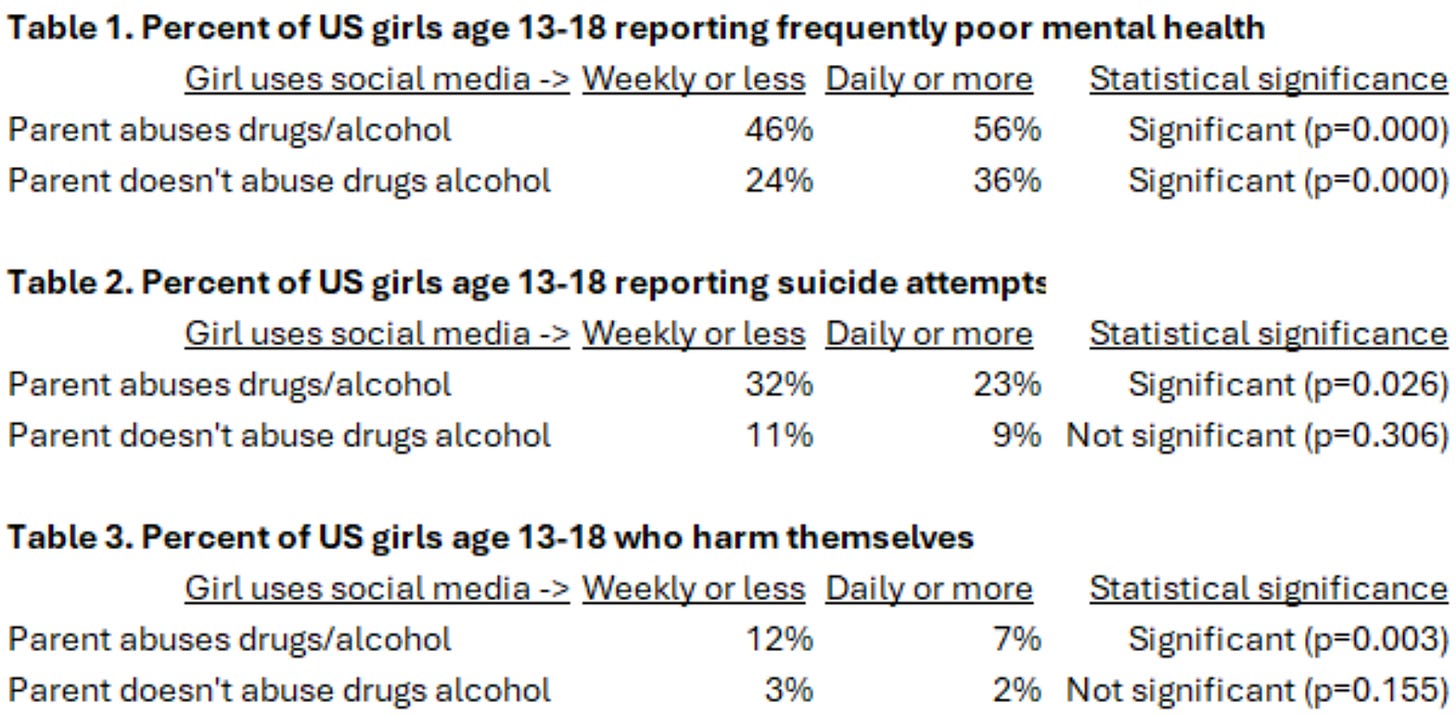Ill-considered social-media bans endanger millions of teenage girls whose online connections help them deal with parents’ skyrocketing addictions
Mike Males, Principal Investigator, YouthFacts.org| November 2025
Surprising Centers for Disease Control numbers show teenage girls, especially those with drug/alcohol abusing parents, have LOWER rates of suicide and self-harm the MORE they use social media.
The fervent concern over girls’ mental health mysteriously vanishes when shocking realities – including from the Centers for Disease Control – challenge official dogmas.
The CDC’s massive 2023 Youth Risk Behavior Survey of 20,000 high schoolers (the gold standard of the teenage “mental health crisis” and the only comprehensive survey available) found a disturbing 34% of girls ages 13-18 are growing up with parents and guardians who abuse drugs and/or alcohol.
Confirming girls’ survey answers is the soaring body count, as pointed out previously. Parent-aged (26-64) adults’ suffered a record 230,000 deaths and 10.7 million hospital emergency cases from drug/alcohol overdoses in 2023 and so far tabulated in 2024, with annual tolls more than doubling in the last 15 years as today’s Gen Z teens grew up.
Despite powerful and blatantly obvious associations of parents’ drug/alcohol abuse and teens’ mental health, suicide attempts, and self-harm, comfortable political, health, and media authorities refuse to engage this disturbing reality that millions of teens cope with in their homes every day.
Instead, authorities shut down all discussion of parental issues and simply blame girls themselves for their mental health troubles. Girls, the popular narrative goes, are just helpless, self-abusing “victims” who make themselves depressed and suicidal by using social media and smartphones.
As a result of self-imposed ignorance and denial, authorities are implementing restrictions and bans that endanger millions of girls whose daily use social media is associated with significant reductions in their risks of suicide and self-harm amid widespread grownup drug and alcohol abuse.
The surprising – and completely ignored – patterns
The CDC survey shows girls age 13-18 are considerably more likely to grow up in homes where parents and grownups abuse drugs and alcohol (34%, versus 25% for boys), suffer severe mental health problems (41% vs. 25%), are violently abusive (35% vs. 30%), are emotionally abusive (70% vs 53%), and have been jailed (19% vs. 16%). It is not clear why girls suffer unhealthier households; perhaps girls take on caretaker roles in troubled families that keep them tied to home more than boys.
Completely ignoring girls’ family conditions, authorities then express shock and dismay that girls also suffer poorer mental health (41% vs 20% for boys), suicide attempt (14% vs. 7%), and self-harm (3.9% vs. 1.4%). It must be that girls use social media more (88% daily, vs. 81% for boys), luminaries puzzle; can’t think of anything else that might be bothering them.
Let’s help the authorities out. The tables below show the progression from being depressed to suicide attempt and self-harm along with girls’ social media use, a point I’ve explored before but now in the context of parents’ rising drug/alcohol abuse.
Table 1 shows the case that social media use causes girls’ poor mental health. Daily social media use is associated with more depression regardless of whether parents abuse drugs/alcohol. Many in the social-media debate don’t seem to realize how superficial the argument for blaming social media for girls’ depression is: simple “correlation equals causation.” The universal approach is simply to stop there: more social media use, more depression, go no further.
Tables 2 and 3 show why it’s crucial that analysts dig deeper.

Source: CDC 2024.
Parental abuse of drugs/alcohol is associated with considerably worse mental health among girls, regardless of girls’ social media use. Further, girls whose parents abuse drugs/alcohol use social media more (47.6% several times an hour) than girls of non-drug/alcohol abusing parents (39.5%).
Now, the unexpected results. Table 2 shows that girls whose parents abuse drugs and/or alcohol have SIGNIFICANTLY LOWER rates of suicide attempt the MORE thsee girls use social media, while girls whose parents don’t abuse drugs/alcohol show NON-SIGNIFICANTLY LOWER suicide attempt levels with more social media use.
For the most injurious mental health outcome the CDC surveyed, self-harm serious enough to require medical treatment, Table 3 likewise shows that in families in which parents abuse drugs and/or alcohol, girls who FREQUENTLY use social media are much LESS at risk of harming themselves than girls who RARELY use social media. Girls in non-addicted families show non-significant results.
Bottom line: girls with drug/alcohol abusing parents and household adults are many times more likely to attempt suicide and/or harm themselves – and frequent social media use is associated with reducing those risks.
These are clear patterns. Why can’t authorities see them?
These results don’t require a lawyer and FOIA petition to unearth. They are directly from the CDC’s official survey, the one that defines the “teenage mental health crisis,” the one everyone uses. Two possibilities emerge, neither edifying.
EITHER major health officials, politicians, and leading social-media authorities are:
– Ignorant of fundamental realities young people face, which means they are not experts at all and are not worthy of the attention they’re getting;
OR they are:
– Aware of but unwilling to face these realities, which means they are appallingly callous, self-serving, and lack normal concern for young people’s well-being.
The next post will further refine CDC survey data that cast authorities, interest groups, and pop-media “experts” in an even worse light.
